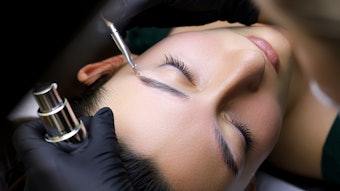
In recent years, there has been a lot of discussion in aesthetics about the use of hydroquinone (HQ) and if excessive use actually forces melanocytes to “regroup” and increase melanin production, resulting in rebound hyperpigmentation and leaving you with even darker spots. HQ does have a place but can create concerns in higher concentrations and long term uses.
Thanks to advanced scientific processes, next-generation lighteners can now serve as effective HQ alternatives, especially since they work with a wide range of skin types and are gentle enough for more sensitive skins which typically rules out HQ. In addition to their brightening properties, they also provide antioxidant, moisture and healing support, and promote cell turnover. RA Pigmentation Solutions work with several botanical lightening agents, but we’ll focus here on just two: Bellis Perennis and Alpha-Arbutin.
What They Are
Bellis Perennis (Daisy Flower). This is a specific species of European daisy native to western, central and northern Europe. An interesting fact, each petal is actually considered an individual flower and the center is a collection of many tiny yellow flowers. In skin care the extract, which is derived from the blossoms of wild daisy flowers, is considered a gentle, yet highly efficient natural skin lightener. Its uses can be traced back to ancient Rome when it was used by surgeons for its astringent properties.
Alpha-Arbutin. This another effective natural skin lightener, is a pure water-soluble, biosynthetic active. It is commonly extracted from the leaves of Bearberry Bush, which is grown primarily in high latitudes like Scotland, Scandinavia, Russia, Alaska, Canada and Greenland. This ingredient can also be extracted from cranberry, blueberry and most types of pears, but the most common source is Bearberry.
Alpha-Arbutin is a natural plant-based derivative of HQ with tyrosinase inhibiting abilities and is typically regarded as a more stable and less sensitizing lightener than HQ. It was developed as an alternative tyrosinase inhibitor to block melanin formation without causing any of the potential side effects that have been linked to the prolonged or excessive use of HQ.
How They Work
Daisy Flower works by influencing different pathways involved in melanin formation, counteracting age spots and balancing hyperpigmentation. Before melanogenesis starts, the active in Bellis Perennis reduces endothelin (the proteins that constrict blood vessels) production in keratinocytes and blocks the binding and transfer of melanocytes. It also decreases tyrosinase synthesis and activity during melanin formation, reducing melanin production in the melanosomes. This powerful ingredient also has ROS scavenging abilities and can reverse existing pigmentation issues.
Alpha-Arbutin effectively reduces the appearance of dark spots, evens skin tone and corrects hyperpigmentation. It works by blocking epidermal melanin biosynthesis, thus inhibiting tyrosinase. In skin, discoloration forms as a result of the pigments eumelanin and phaeomelanin, which are produced in certain epidermal cells (or melanocytes).
Tyrosinase forms in these melanocytes and when activated by UV light an enzymatic chemical reaction occurs called melanogenesis, which ultimately leads to the formation of melanin. Arbutin blocks this process by inhibiting the oxidation of tyrosinase and dopa. This characteristic of Arbutin makes it a faster, more efficient skin-lightening active than any existing single lightening ingredient.
Where to Find Them
Many of the lightening and brightening formulas found in Pigmentation Solutions use these powerful botanical ingredients, a few of which include:
- SKIN BRIGHTENING CLEANSE – Radiant Glow
- BRIGHTENING SCRUB – Polish + Glow
- BRIGHTENING PIGMENT TONIC – Illuminating Toner
- NATURALÉ MEGA BRIGHTENING SERUM – Advanced Pigment Complex
- SKIN BRIGHTENING ENZYME – Depigment Treatment
On the brighter side, though HQ certainly has its place in professional aesthetics, next-generation botanical brighteners provide an amazing alternative – especially for more sensitive skins or those that may be leery of skin lightening programs.
Disclaimer:
The above paid-for content was produced by and posted on behalf of the Sponsor. Content provided is generated solely by the Sponsor or its affiliates, and it is the Sponsor’s responsibility for the accuracy, completeness and validity of all information included. Skin Inc. takes steps to ensure that you will not confuse sponsored content with content produced by Skin Inc. and governed by its editorial policy.










